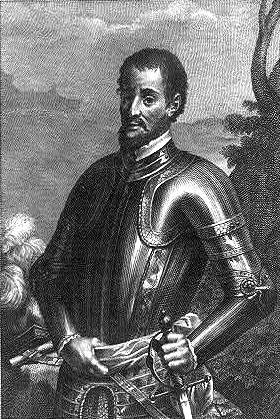Birth c. 1500 (exact date unknown) and Death 21st May, 1542
Hernando de Soto, born in the 15th Century was a Spanish explorer and conqueror. He was known for his expeditions and conquests of Central America and Peru. His explorations led him to discover the river Mississippi and also outlined many countries like Florida, Georgia, Alabama, etc. which later went on to become the present-day United States.
The Early Life of Hernando de Soto
Contents
Hernando de Soto was born in Jerez de los Caballeros in the province of Badajoz, Spain. Although Hernando belonged to a noble family, they were poor and struggled for daily living. He lived with his parents in their family manor house. Hernando’s father wanted his son to become a lawyer and with the help of Pedro Arias Dávila, a wealthy patron enrolled him to the University of Salamanca, but young Hernando had other plans.
Hernando expressed his desire to become an explorer and he left for Seville to explore the continent of West Indies. Hernando was an avid horseman and his enthusiasm earned him a place in the cavalry exploration troop of Dávila, the Governor of Darién and soon he was appointed the Captain in 1514.

The Explorations of Hernando de Soto
Hernando set out for Panama and wanted to explore and conquer Nicaragua and Honduras. There he made huge fortunes while trading with the natives and through slave trading. In the subsequent years 1524-27, Hernando defeated Gil González de Ávila and gained control of Nicaragua and expanded his business and made more profits through trading of Indian slaves.
After Dávila’s death in 1531, Hernando joined the troop of Francisco Pizarro and started the expedition for gold in south of Darién on the Pacific Coast and set out for the conquest of Peru. Pizarro soon appointed De Soto as his chief lieutenant.
The Conquest of Peru
In 1532, Pizarro’s army led by De Soto set out for Peru. In 1533, De Soto and his troop came across Cuzco, which was then the capital and now is mostly known for its archaeological remains of the Inca Empire. Here Hernando has played a pivotal role in the conquest of Cuzco and the capture and defeat of Atahuallpa, the leader of Inca Empire. Pizarro under the command of De Soto captured Atahuallpa and held him captive in his tent.
Atahuallpa in return of his release promised to fill the tent with gold and silver. Both Pizarro and Fernando made huge profits from this arrangement. Later Atahuallpa was executed by strangulation in August 1533 and this marked the end of the Inca Empire. In 1534, Soto became the Lieutenant Governor of Cuzco. He applied for the post of second-in-command of King Charles in 1535, which was declined. So dissatisfied, Soto accumulated his share of riches and decided to return to Spain.
Soto’s Life in Spain
Soto returned to Spain in 1536 where he was awarded by the King of Spain with the “Order of Santiago” and was granted the “the right to conquer Florida”. He also received his share of wealth and was granted 724 marks of gold and 17,740 pesos. There De Soto married Isabel de Bobadilla, the daughter of Padrarias Dávila. De Soto soon became one of the richest men in Spain and was having a comfortable life.
But as the keen explorer he was, he soon began to hear stories of the explorations of Florida and the enormous riches of the Gulf coasts. So, Soto sold all his riches and used the money to prepare for his next expedition to North America.
Soto’s Journey to North America
Soto with his crew of 700 efficient men and 10 ships, set out for his next journey to Sanlúcar on April 6, 1538. On their way to the United States, Soto and his team of men stayed in Cuba and helped the city of Havana which was ransacked and burnt by the French army. On May 18, 1539, the troop set out for Florida and stopped on Tampa Bay on May 25. After that, they moved towards Georgia and then Tennessee.
Here they did not find much gold, but made some money trading pearls and the native Indian slaves. After that, they moved to Alabama and fought with the Indians of Tuscaloosa. De Soto and his army won the battle and they headed westward which led to the famous discovery of the mouth of the Mississippi River.
Death of De Soto
De Soto died of fever on May 21, 1542, in Ferriday, Louisiana. It is believed that his crew members floated his body into the river.
Though his explorations badly afflicted the relationship between the natives and the Europeans due to his harsh behaviour towards them we also cannot deny that he, in fact, pioneered the first ever European and Spanish expedition which resulted in discoveries of new territories of the modern world.
